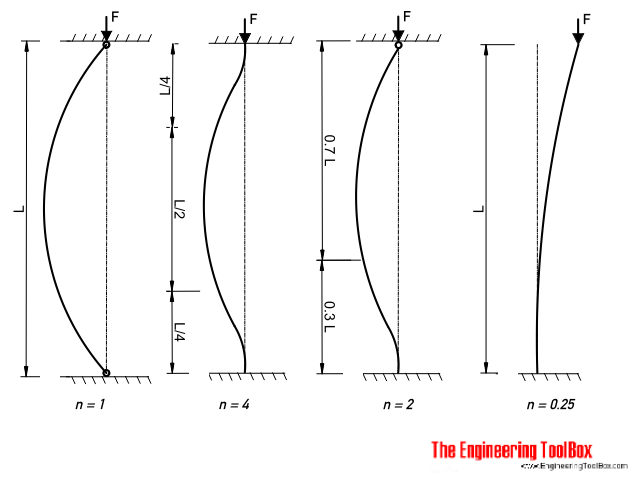Euler Column Buckling: Formula, Theory & Calculator
Calculate buckling of columns.

Columns fail by buckling when their critical load is reached. Long columns can be analysed with the Euler column formula
F = n π2 E I / L2 (1)
where
F = allowable load (lb, N)
n = factor accounting for the end conditions
E = modulus of elastisity (lb/in2, Pa (N/m2))
L = length of column (in, m)
I = Moment of inertia (in4, m4)
Factor Counting for End Conditions

- column pivoted in both ends : n = 1
- both ends fixed : n = 4
- one end fixed, the other end rounded : n = 2
- one end fixed, one end free : n = 0.25
Note!
Equation (1) is sometimes expressed with a k factor accounting for the end conditions:
F = π2 E I / (k L)2 (1b)
where
k = (1 / n)1/2 factor accounting for the end conditions
| n | 1 | 4 | 2 | 0.25 |
| k | 1 | 0.5 | 0.7 | 2 |
Example - A Column Fixed in both Ends
An column with length 5 m is fixed in both ends. The column is made of an Aluminium I-beam 7 x 4 1/2 x 5.80 with a Moment of Inertia iy = 5.78 in4. The Modulus of Elasticity of aluminum is 69 GPa (69×109 Pa) and the factor for a column fixed in both ends is 4.
The Moment of Inertia can be converted to metric units like
Iy = 5.78 in4 (0.0254 m/in)4
= 241×10-8 m4
The Euler buckling load can then be calculated as
F = (4) π2 (69×109 Pa) (241×10-8 m4) / (5 m)2
= 262594 N
= 263 kN
Slenderness Ratio
The term "L/r" is known as the slenderness ratio. L is the length of the column and r is the radiation of gyration for the column.
- higher slenderness ratio - lower critical stress to cause buckling
- lower slenderness ratio - higher critical stress to cause buckling
- slenderness ratios L/r < 40: "short columns" where failure mode is crushing (yielding)
- slenderness ratios 40 < L/r < 120: "intermediate columns" where failure mode is a combination of crushing (yielding) and buckling
- slenderness ratio of 120 < L/r < 200: "long columns" where failure mode is buckling



